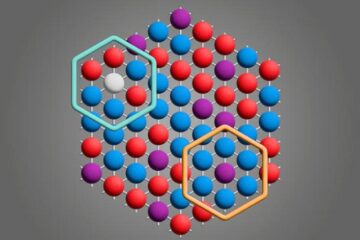Laying Microscale Tiles

Craftsmen tile walls or floors by hand; but how can you get an ordered monolayer onto a substrate when the “tiles” are microscopically small instead of big and easy to handle? Previously, self-assembly processes have been the method of choice for this scale. Korean researchers have now come to the realization that even such tiny components can be arranged in a “do-it-yourself” method. As they describe in the journal Angewandte Chemie, their manually produced monolayers of microcrystals are qualitatively superior to the self-assembled variety.
How small can components be such that they can still be glued to a surface by hand? And conversely, how big can microscale components be such that they can still be arranged by self-assembly? Which method is best in the size range in which both techniques work? These questions have been investigated by a team led by Kyung Byung Yoon at Sogang University in Seoul. To find answers, they carried out experiments with variously sized zeolite crystals. Zeolites are aluminosilicate minerals with a wide range of applications in many technical fields.
The powdered zeolite was applied by simply rubbing it on with a finger (with and without wearing a latex glove). Alternatively, they were applied in solution, and ultrasound was used to kick-start the self-assembly process. The “glue” between the “mini-tiles” and the substrate was the attraction between oppositely charged groups of atoms, hydrogen bonds, and chemical bonds between reactive groups of atoms.
The experiments demonstrated that self-assembly only works for particles smaller than about 3 µm. Hand-application works for crystals as small as 0.5 µm in diameter. In the overlapping range (0.5 to 3 µm), hand application is preferable to self-assembly for quality: the packing is denser and the microcrystals are oriented more regularly. Whereas self-assembly produces individual crystals grown at a 90° angle onto the monolayer, such “parasites” are simply rubbed off by hand. There are other “handy” advantages of the manual process as well: it is simpler, doesn’t require a solvent or special equipment, runs more smoothly, and allows treatment of larger surfaces.
Author: Kyung Byung Yoon, Sogang University, Seoul (Korea), http://www.sogang.ac.kr/bbs/faculty/2profile.php?para=101191
Title: Manual Assembly of Microcrystal Monolayers on Substrates
Angewandte Chemie International Edition 2007, 46, No. 17, doi: 10.1002/anie.200604367
Media Contact
All latest news from the category: Life Sciences and Chemistry
Articles and reports from the Life Sciences and chemistry area deal with applied and basic research into modern biology, chemistry and human medicine.
Valuable information can be found on a range of life sciences fields including bacteriology, biochemistry, bionics, bioinformatics, biophysics, biotechnology, genetics, geobotany, human biology, marine biology, microbiology, molecular biology, cellular biology, zoology, bioinorganic chemistry, microchemistry and environmental chemistry.
Newest articles

Microscopic basis of a new form of quantum magnetism
Not all magnets are the same. When we think of magnetism, we often think of magnets that stick to a refrigerator’s door. For these types of magnets, the electronic interactions…

An epigenome editing toolkit to dissect the mechanisms of gene regulation
A study from the Hackett group at EMBL Rome led to the development of a powerful epigenetic editing technology, which unlocks the ability to precisely program chromatin modifications. Understanding how…

NASA selects UF mission to better track the Earth’s water and ice
NASA has selected a team of University of Florida aerospace engineers to pursue a groundbreaking $12 million mission aimed at improving the way we track changes in Earth’s structures, such…





















